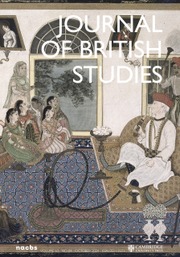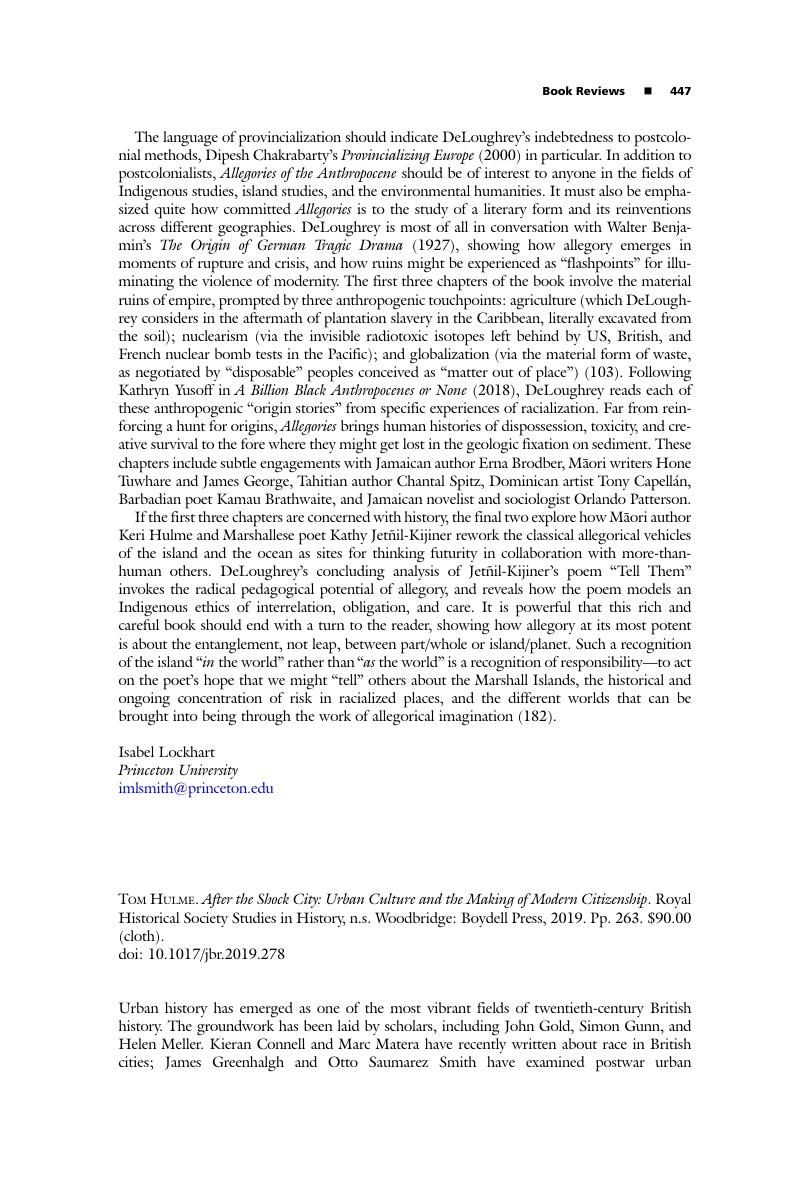Urban history has emerged as one of the most vibrant fields of twentieth-century British history. The groundwork has been laid by scholars, including John Gold, Simon Gunn, and Helen Meller. Kieran Connell and Marc Matera have recently written about race in British cities; James Greenhalgh and Otto Saumarez Smith have examined postwar urban redevelopment; and a slew of first books are on their way from, among others, Alistair Kefford, Sarah Mass, Jesse Meredith, and Sam Wetherell. Of course, singling out particular names unforgivably omits others, but that fact itself makes the point: if you teach twentieth-century British history, and your course does not include a significant urban dimension, you have a lot of reading to do.
Into this flourishing field arrives Tom Hulme's After the Shock City: Urban Culture and the Making of Modern Citizenship. Hulme's subject is the city as a site through which citizenship is forged, claimed, and lived, considered through the cases of Manchester and Chicago. He examines these two “shock cities,” the frontiers of industrialization and urbanization, at a pivotal moment in their histories: after their defining nineteenth centuries, but before the dissolution of urban citizenship that he dates from the 1940s. Hulme wants to put “the city back into citizenship” (6), arguing in the conclusion, “The modern city was not simply a passive container for larger or broader discourses of citizenship, but a key aspect of how they were articulated, experienced, and contested” (214). He roots this history in the nineteenth century but departs from prior scholarship by following it through the interwar decades. Then, in five closely argued chapters, Hulme examines the forging of urban citizenship in the domains of education, festivals, pageants, youth, and welfare. “The disorganised and degenerative city of the past,” he writes, “was now presented as the antipathy of the fruits of good government and urban regulation in the present—from shock city to citizenship city” (55).
Readers will learn much from this well-constructed book. Its comparative approach is deftly handled, toggling smoothly between Manchester and Chicago. These cases were comparable, but not identical: Manchester had no equivalent to the 40,000–80,000 Ku Klux Klansmen in America's second city, but its civic performances did exceed Chicago's in their efforts to efface the role of women in public life. At several points, especially in the chapters on festivals and pageants, a telling shift appears in Chicago's approach to integrating immigrants: from the “melting pot” of the 1920s, to something more like multiculturalism during the 1930s—though with African Americans serving as the ideology's outer limit in each case. The excellent chapter 4 examines the interwar vogue for historical pageants, through which cities reimagined and performed their relationships to the past. In Manchester, this meant situating a nineteenth-century city into a longer history, stretching back to Roman times, whereas in Chicago, a more foreshortened European history compelled a different kind of narrative, one that celebrated the violent displacement of Native American “savages.” Chapter 6, “Civic Culture and Welfare”—another strong entry—illustrates the book's contention about the city as an agent, and no mere stage, in making modern citizenship. Hulme shows, counterintuitively, that the nationalization of welfare services, which in time would come to compromise the city's status as a site of citizenship, initially created new opportunities for civic management and belonging. Ultimately, however, the centrifugal forces of wartime nationalism and postwar nationalization caused the city to lose its hold, in an argument that fits with David Edgerton's Rise and Fall of the British Nation (2018).
The book would have benefitted from a pair of maps, providing readers with a sense of the geography of each city. And Hulme so convincingly reveals the city to have functioned as a site of citizenship that it begs the question, pursued elsewhere by Sarah Mass, as to how that function might have persisted beyond the 1940s and 1950s. Ultimately, though, amid that recent efflorescence of urban historiography, this book stakes its claim in at least two ways. For all of its achievements, the emerging urban literature skews post-1945; and it often remains stubbornly domestic in its framing. In this light, then, Hulme not only focuses upon the interwar decades, joining Charlotte Wildman-Tarozzi's Urban Redevelopment and Modernity in Liverpool and Manchester, 1918–1939 (2016), but he locates his subject within a longer periodization stretching from the nineteenth century to the 1950s. And the book is further distinguished by its comparative framing—respecting national differences, but not naturalizing them, in ways that echo Simon Gunn and Susan Townsend's exemplary Automobility and the City in Twentieth-Century Britain and Japan (2019). In terms of both method and content, then, After the Shock City represents a welcome contribution to the thriving field of British urban history.



